I am not canning any of my salsa this year, but don’t worry! I’m still putting fresh salsa up (what’s taco night without pico de gallo?), I’m just making this lacto-fermented salsa recipe instead! Fermenting is the only form of food preservation that actually increases the nutritional profile of your food.
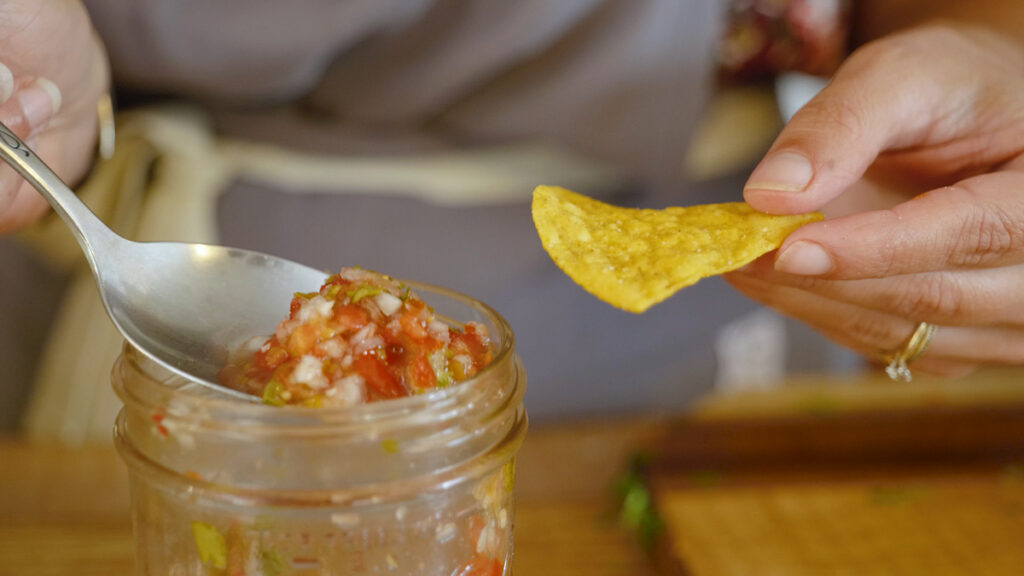
Table of Contents[Hide][Show]
🍞 Struggling With Sourdough?
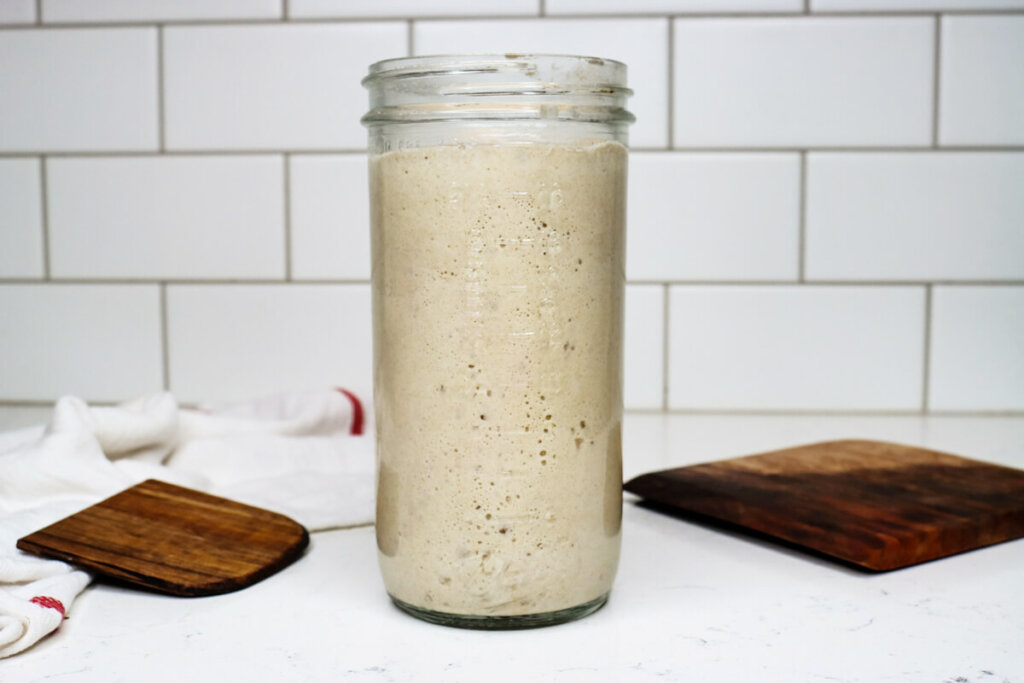
If your starter won’t take off, your loaves are dense and hard, or sourdough just flat-out overwhelms you…
👉 I’ll show you how to fix all of it.
Join my FREE live workshop and learn how to make a bubbly, active starter—the right way, from Day One.
🗓️ Jan 12 @ 1pm PT
Why I love Fermenting
One of the beautiful things about lacto-fermenting is that if you only have a few tomatoes for a few jars, say at the end of the season, you don’t have to heat up the kitchen or spend a lot of time canning them. I love homesteading, but I’m all for finding hacks to make my life easier! I am a modern pioneer, after all!
Fermented foods give you this wonderful array of probiotics and raw nutrients. In its raw form, it provides the added benefit of good bacteria, which is good for your gut health. I love using the medicinal foods of our great-grandmothers. Learn more about the health benefits of fermentation here. (Source)
I’m sure you’ve all heard of sauerkraut, kimchi and sourdough, but there are many other ways to enjoy fermented foods like kefir, kombucha, alcoholic beverages, and more. We love fermented fruits and vegetables like fermented peppers and fermented lemons.
What I love about this recipe is that, through fermentation, the initial bite of raw onions and garlic is minimized, making these two ingredients much more enjoyable in their raw form. But don’t you worry, the fresh cilantro and diced tomato flavor shine through like a champ! Try it on top of Instant Pot chili or grab those homemade tortillas, and let’s have taco night!
Why Salt is So Important in Fermenting
In canning, salt is optional. For fermenting, salt is necessary. Salt is what inhibits bad bacterial growth, while good bacteria can multiply.
It also helps prevent mold growth. But not any salt will do! You don’t want to use table salt when fermenting. You want good quality sea salt (more on this below). Learn more about the basics of fermenting vegetables here.
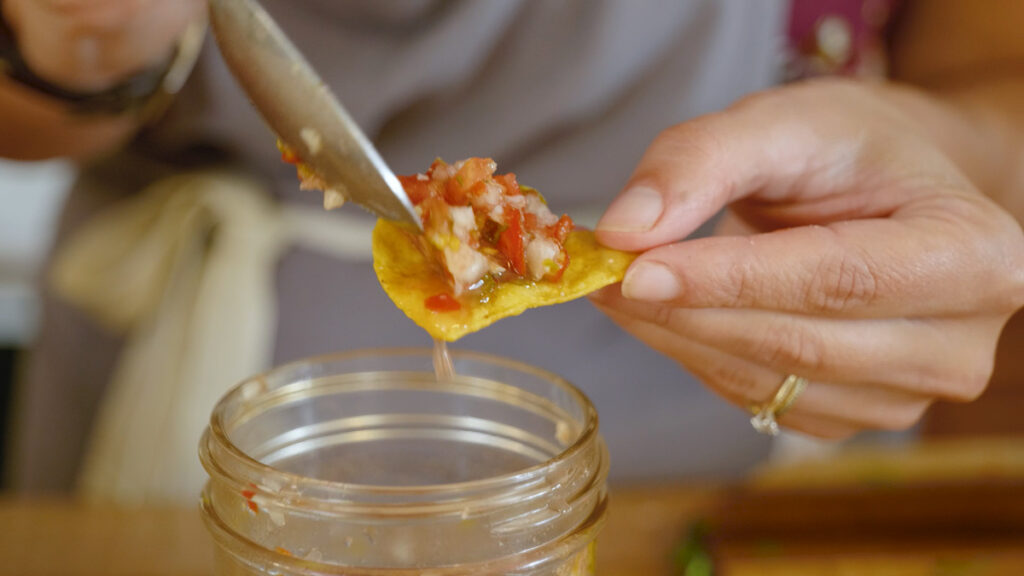
Subscribe to Melissa K. Norris!
Get updates on the latest posts and more from Melissa K. Norris straight to your inbox.
We use your personal data for interest-based advertising, as outlined in our Privacy Notice.
How Long Will My Salsa Keep?
You can keep your homemade salsa in cold storage for a short time (such as a root cellar/basement kept at 50 degrees or less). For longer-term storage, temperatures in the upper 30s and 40s work best.
Your fermented salsa condiment will last for months (and even up to a year and a half) in the fridge.
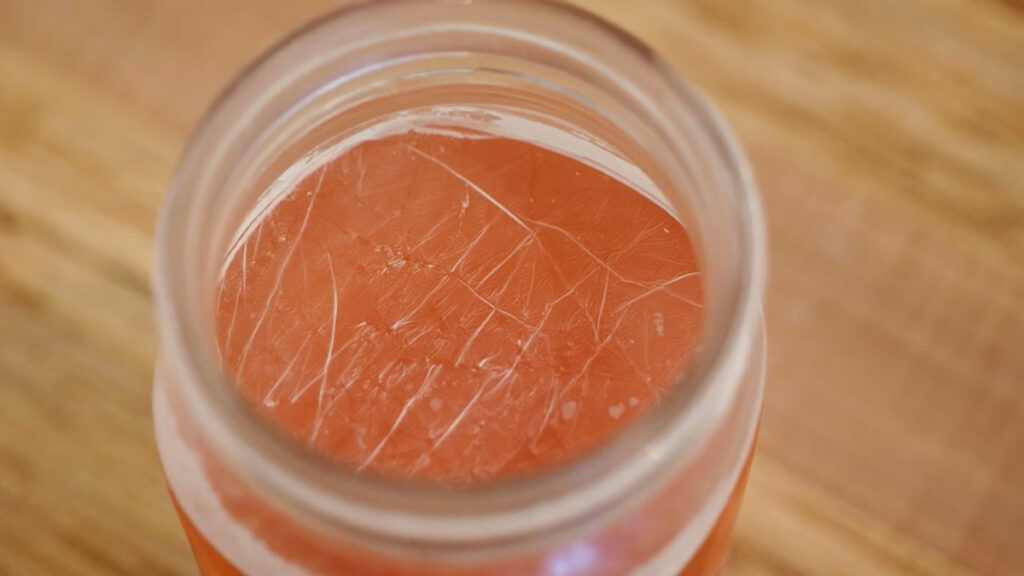
Watching for Mold
Most people make the mistake of throwing out perfectly good food when they see anything form on the top of their food.
While mold is terrible and filled with bad bacteria, Kahm Yeast is wonderful and is generally found when beneficial bacteria is present. Read this post on how to spot kahm yeast here to know the difference between the two.

Everything Worth Preserving
Looking for more fermented recipes? Discover the nine home food preservation methods to safely store delicious food for year-round eating with all of my step-by-step tutorials, recipes, and easy-to-use charts.
Learn everything you need to know about cold storage (aka freezer), water bath/steam canning, pressure canning, dehydrating, fermenting, freeze-drying, root cellar, infusion, and salt/curing in the new book, Everything Worth Preserving.
Preserve food for a healthy well-stocked pantry & peace of mind, all in one resource.
In this book, you can search for any produce from A-Z and get a list of all the ways to preserve that item, plus recipes! Grab your copy (and FREE bonuses for pre-ordering) here.
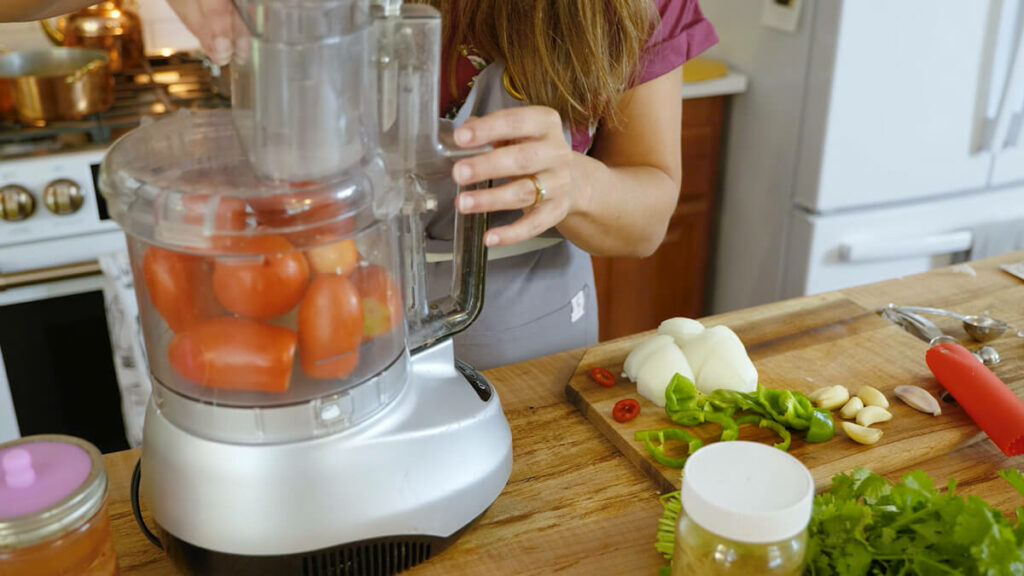
Fermented Salsa Recipe
Supplies Needed to Ferment Salsa
- Food processor – This is optional, but it sure speeds up the process.
- Cutting board – To prep the veggies before putting them into the food processor.
- Knife – Also for prepping the veggies before putting them into the food processor.
- Two 1 1/2 pint jars (or one pint and one quart jar) – You’ll want your jars washed well in hot soapy water, then rinsed completely so no soapy residue remains as this can inhibit the fermenting process.
- Funnel – No one likes to make a mess in the kitchen!
- Fermenting weights – These will help keep the ferment under the liquid of the brine, preventing mold.
- Air Lock Lids – These can be any kind of fermenting lid, whether a Pickle Pro, an airlock lid, or, if you don’t have access to these, just a plastic Mason jar lid will work as well. Don’t use a two-piece canning lid as the pressure of the ferment can build up and cause the jar to break (because who remembers to burp them often enough, right?). You can generally find something affordable on Amazon.
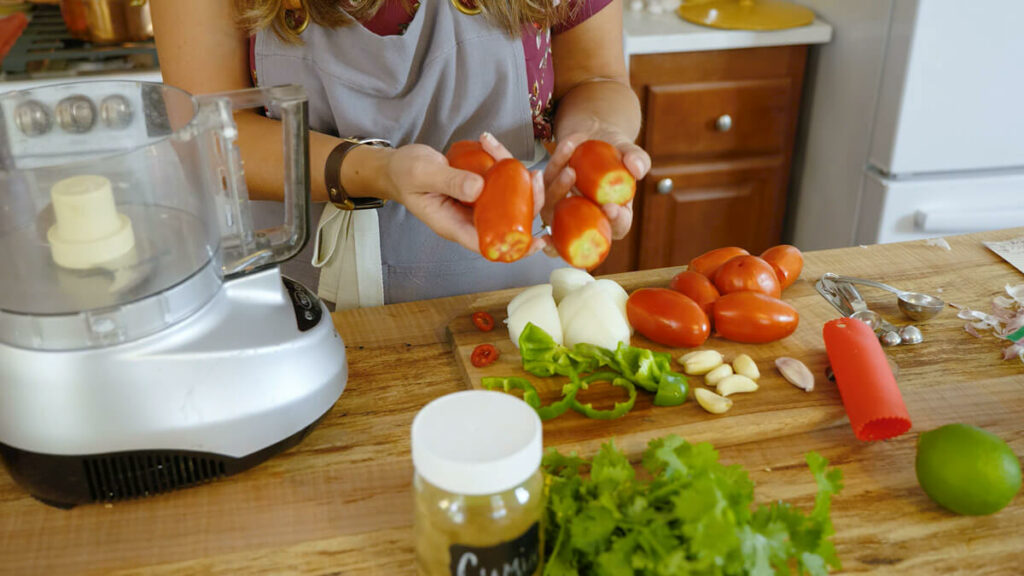
Ingredients Needed for this Fermented Salsa Recipe
- Roma tomatoes – Any tomatoes will do, this just happens to be what we had ripe in the garden. You’ll want about 1 1/2 pounds of fresh tomatoes for this recipe. (This is a great recipe if you happen to have a flush of ripe tomatoes all at once or score a good deal on tomatoes at the Farmer’s Market!)
- Onion – Red onion, yellow onion, sweet onion, the choice is yours!
- Bell Pepper – I like adding bell peppers to my salsa. For this fermented salsa, it helps keep some bite to the finished product as vegetables tend to soften up during the fermentation process.
- Jalapeno Peppers – If you like it spicier, go for the whole jalapeno. I’m only adding half for this recipe. You could also add the seeds for more heat. If you don’t have jalapenos, any hot pepper you like will work.
- Garlic – More garlic is always better, in my opinion! Add more or less cloves garlic to your preference.
- Cumin – This gives the salsa that classic Mexican flavor!
- Cilantro – This is optional. I know some people don’t care for the flavor of cilantro. Our family loves it, so we’ll use it in this recipe.
- Fresh or bottled lime juice – This adds a great flavor after the salsa has fermented. It’s optional, but definitely recommended.
- Redmond Red Salt – It may seem like a lot of salt for this recipe, but remember that this is a ferment, and salt is necessary for a safe fermentation.
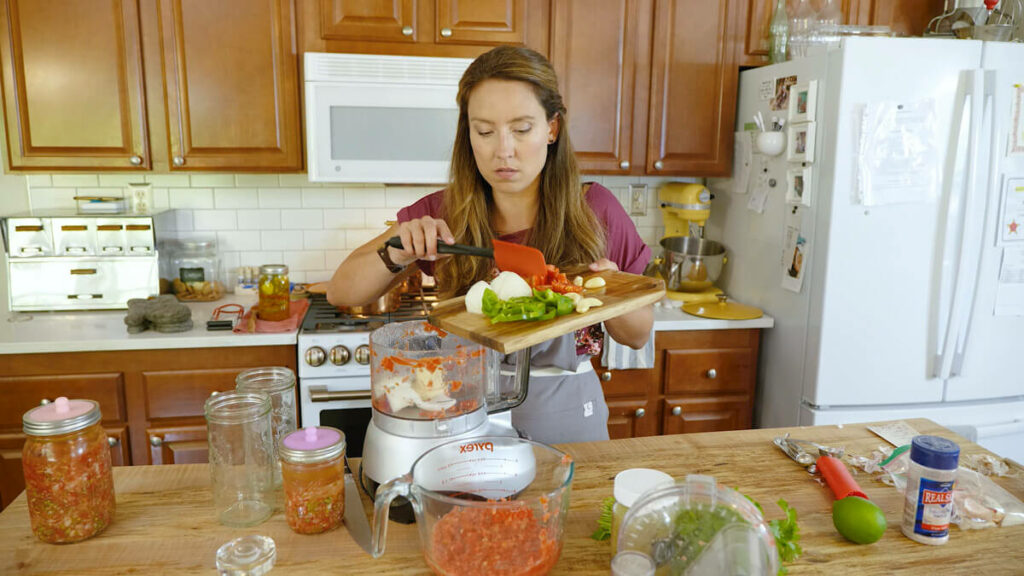
Fermented Salsa Directions
1. Start by putting the tomatoes into the food processor and pulsing until chopped. You don’t want to liquefy them.
2. Pull out any large chunks of tomato and cut them up to your desired size. Pour the tomatoes into a large bowl.
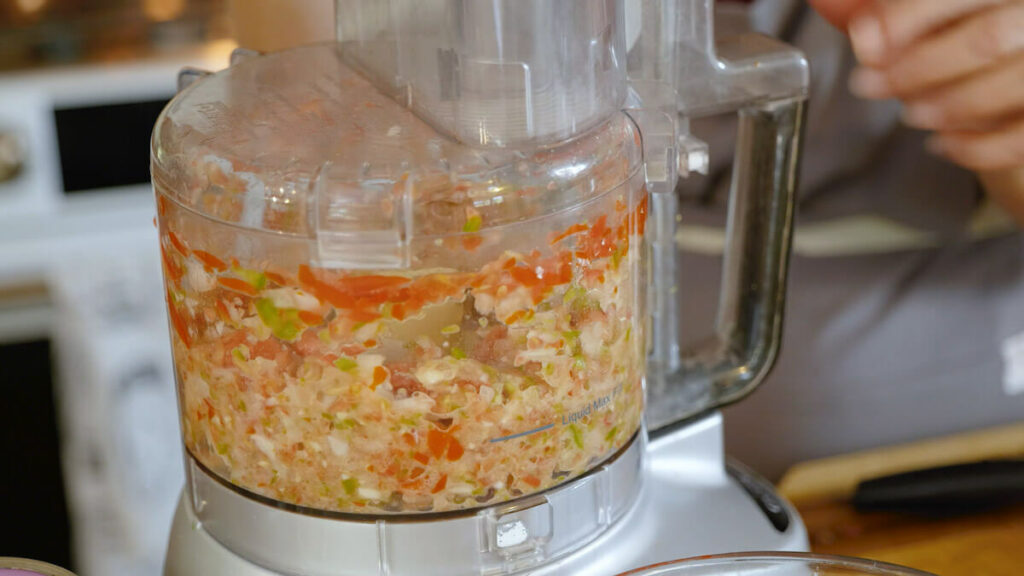
3. Put the rest of the vegetables in the food processor and pulse until chopped to your desired consistency.
4. Add the rest of the chopped veggies into the bowl with the tomatoes
5. Add the cumin and mix well.

6. Some people like cilantro, and some don’t, so add the cilantro if you choose.
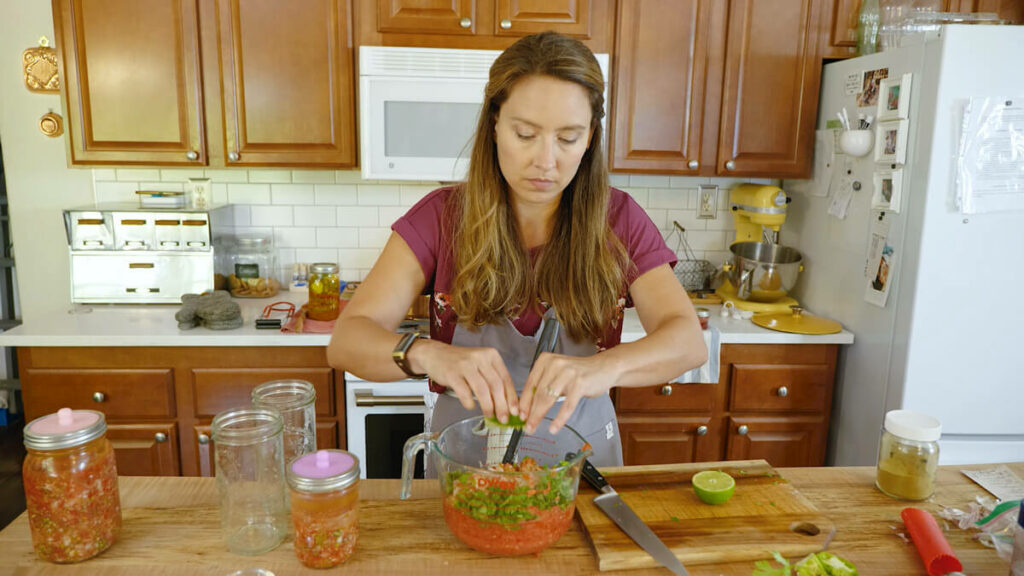
7. Add the optional fresh or bottled lime juice and stir again.
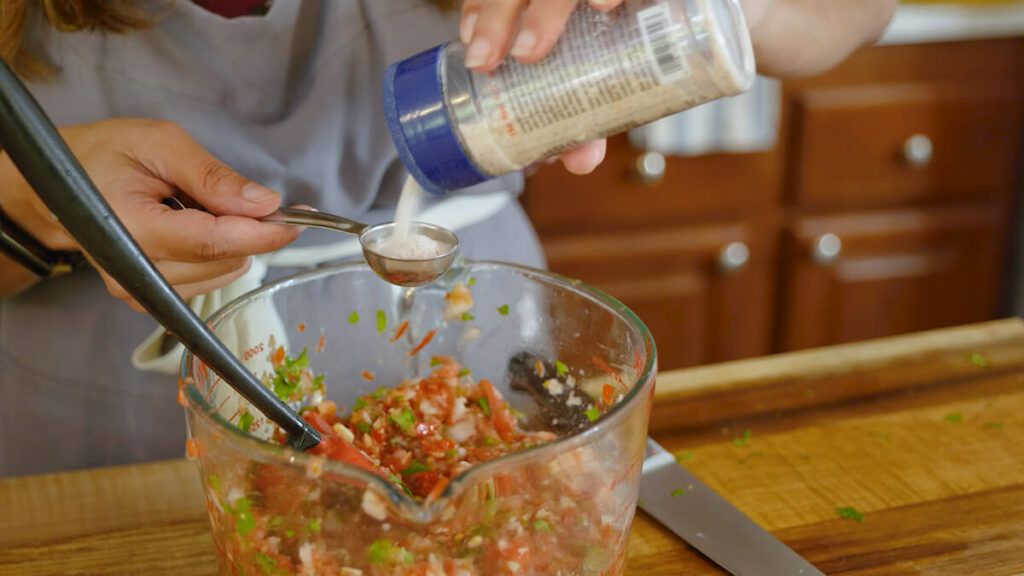
8 And finally, add Redmond Red Salt. I use this salt for everything because it has no iodine, no anti-caking agents, and no other added ingredients. You can optionally add some whey to get the fermentation process started on the right foot, but this isn’t necessary and I tend to omit it.
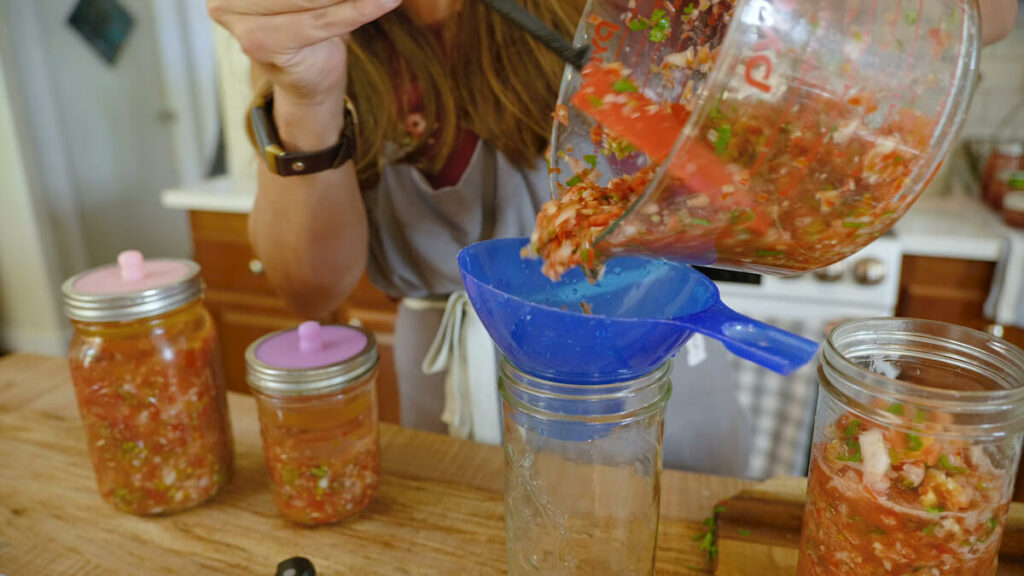
9. Use a funnel to pour salsa into jars, leaving enough room for the fermentation weight and about a half inch of headspace.
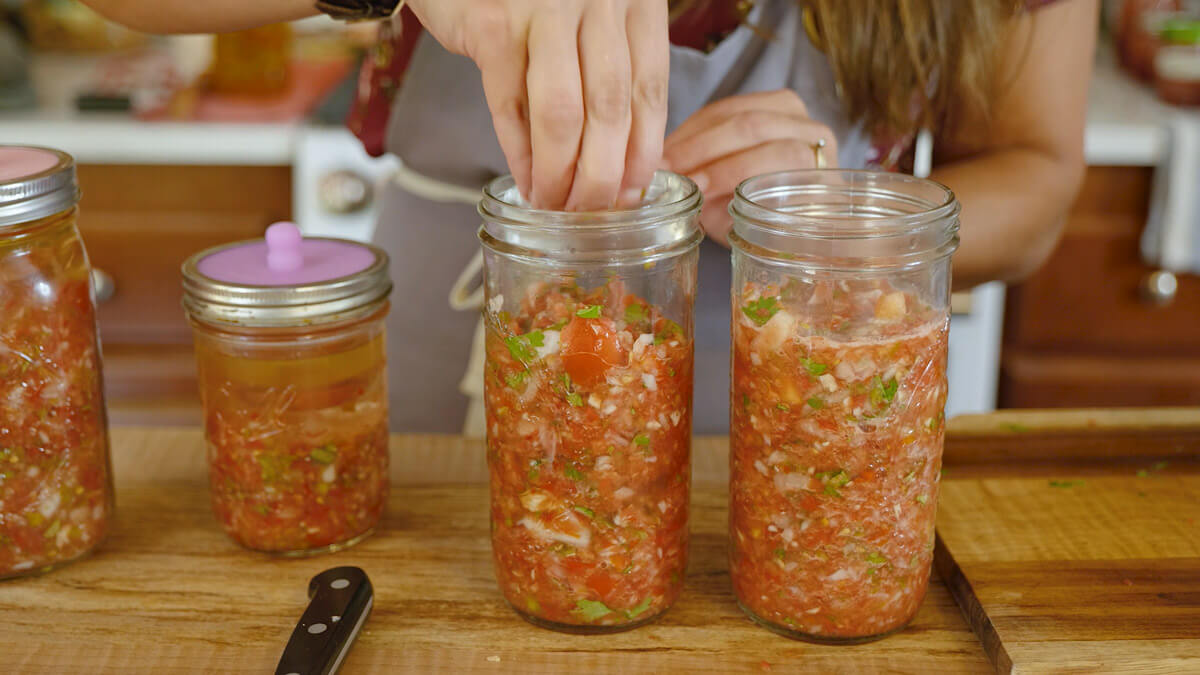

10. Add the fermentation weights into the jars and push the solids well beneath the liquid line. Adjust by adding or removing some of the salsa to ensure you have a half inch of headspace. This will allow for space for the fermenting bubbling to take place.
Pro Tip: Bubbling or fizzy salsa can be strange the first time you see it. It’s perfectly fine and means the lactic acid is building and things are happening, but you don’t want your salsa to overflow, so leaving a space at the top of the jar helps with this.
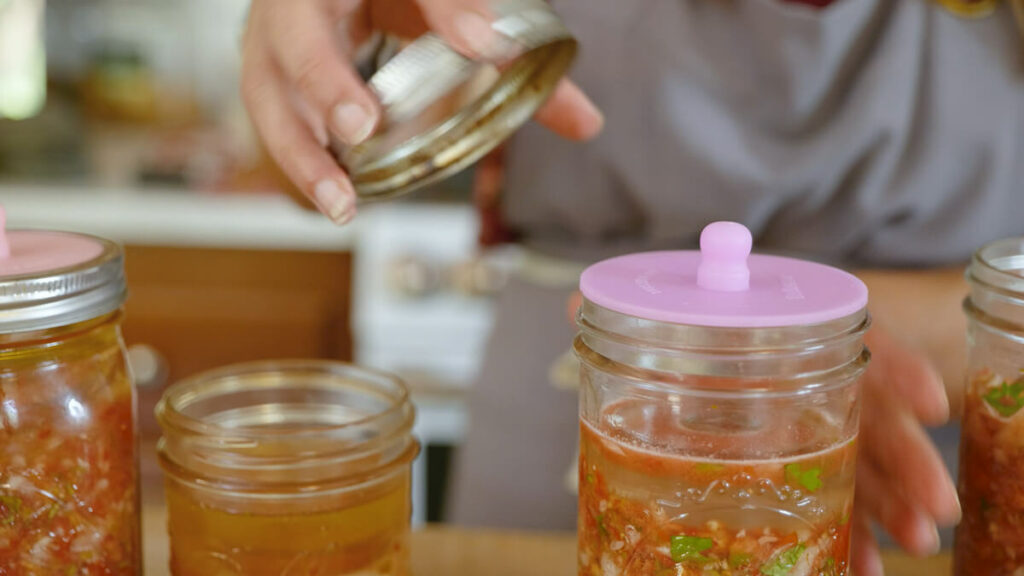
11. Add your fermentation lid and let your salsa sit at room temperature (out of direct sunlight) for three days. If you’re nervous about the liquid spilling out of the top of the jar, you can always set your jars on a plate.
Pro Tip: The warmer the room, the faster the fermentation time. Taste your salsa after three days, and if it tastes great, move it to long-term cold storage.
You can consolidate your salsa to one jar and use plastic lids to store in the refrigerator. Still, make sure the solid is kept beneath the liquid.
More Posts You May Enjoy
- Storing Green Tomatoes for Fresh Eating
- The Ultimate Guide to Making Fermented Peppers
- Fermented Pickles Recipe
- The Best Fermented Hot Sauce Recipe
- Kahm Yeast (What, Why & Does it Ruin a Ferment)
- Fermentation for Health Benefits
- Ultimate Guide to Fermenting Vegetables
- Creamy Red Potato Salad
- 8 Tips for Strengthening Your Immune System Now
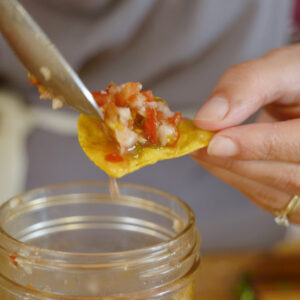
Fermented Salsa Recipe
Ingredients
- 1 1/2 pounds tomatoes quartered
- 1 onion quartered
- 1 bell pepper quartered
- 1/2 jalapeno sliced
- 7 cloves garlic peeled
- 3/4 teaspoon cumin ground
- 1/2 cup cilantro chopped (optional)
- 1/2 Tablespoon lime juice fresh or bottled
- 1 Tablespoon Redmond Real Salt
Instructions
- Start by putting the tomatoes into the food processor and pulsing until chopped. You don't want to liquefy them.
- Pour tomatoes into a bowl.
- Pull out any large chunks and cut them up to your desired size.
- Put the rest of the vegetables in the food processor and pulse until chopped to desired size.
- Mix them with the tomatoes in the bowl.
- Add the cumin and mix well.
- Add cilantro, if using, and mix well.
- Use salt and mix well.
- Use a funnel to pour salsa into jars.
- Add fermenting weights into the jars to push the solids well beneath the liquid line, and make sure you keep about 1/2 inch free at the top.
- Add airlock lids (if using) and allow to sit at room temperature for three days.
Notes
- Let salsa sit for three days, then give it a taste test to see if it’s to your desired flavor. Continue to ferment until it’s to your liking, transfer to cold storage.
- You can keep your salsa in cold storage – a refrigerator or a root cellar/basement if kept at 50 degrees or less. For long-term storage, the upper 30s and 40s work best.
It will last for months and even up to a year and a half in the fridge. - Be sure check out my blog post on kahm yeast to make sure you know what to watch for.
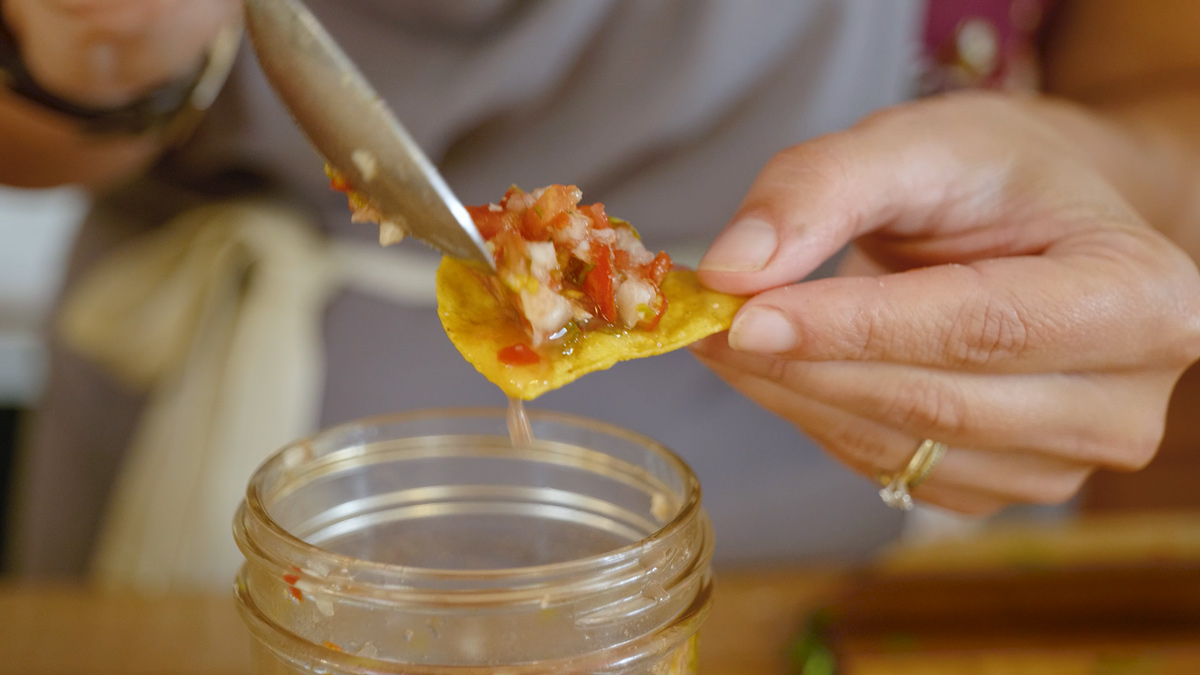

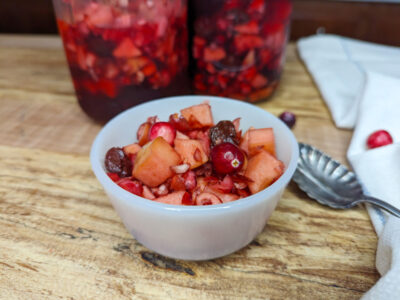
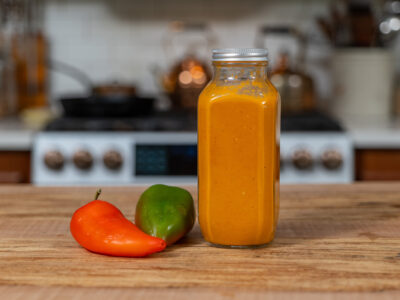
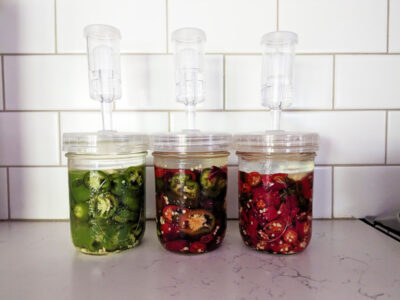






https://continent-telecom.com/virtual-number-ukraine-kiev
Should I just double the recipe if I want to use a 2 quart jar?
Thanks!
Hi – love the recipe. Can I double or triple the recipe and make this in a 1/2 gallon canning jar(s)?
Any suggestions on what to improvise instead of weights? From a previous suggestions it seems that parchment paper can be used instead of a lid. Would a plastic jar lid be okay. I have plastic lids that fit a canning jar. But what about the weights?
Thank you.
Last year I tried my first fermentation ever. I followed a cabbage/beets ferment recipe. After one month I noticed no bubbling in the jar. I waited for three months and did not observe any fermentation. I tasted the contents and noticed no flavor of fermentation. I threw it away.
Five days ago I tried another cabbage/beets recipe in a ½ gal. jar. On that same day I followed your fermented salsa recipe and used two quart jars. Yesterday I did not notice any gas bubbles going to the surface and I am familiar with airlocks during the making of my wine. I did notice that there were air bubbles throughout the ingredients so I started to bang the bottles on the table and lots of gas floated to the top. Today I noticed that the fermentation is working because there are lots of bubbles floating to the surface. My question to you is since the ferment for the salsa is working fine today, should I wait several days tor the fermentation to subside or just put it in the refrigerator and consider it done.
If am using brine from a previous ferment, can I cut the salt down? If so, how much?
Can I use my own salsa recipe and just add the salt? Or is this recipe down to a science?
I just had to comment on this recipe. I am always loathe to make my tomatoes into anything to preserve except sauce or whole because both are completely versatile but I realized that I was spending a huge amount of money every year on organic salsa so I decided to climb out of my rut. I used several pint jars for the ferment itself and then combined them afterwards for storage in the fridge. Not only does my family love it but I was teaching a local group on fermenting and it was a huge hit in the taste testing! I’ve enjoyed so many of your recipes over the years but I just had to comment on this one!
I just wanted to thank you for this recipe, as it has now become a family favorite that we look forward to every summer. I love that I can put this in the fridge and it lasts for months (if I can hide it from my family for that long!) so I make as much as I possibly can, even purchasing tomatoes from a farmers market if needed. Most of us do not usually enjoy fermented foods and I bought the fermenting supplies just for this recipe and it has been completely worth it!
Can I use any salsa recipe to ferment? Can I use canned tomatoes? Can I use pink Himalayan salt? Thanks for your tutorial!
Hi Melissa,
I followed this recipe exactly and it was so salty we could not eat it. Do you have any suggestions?
Did you use the Redmond’s salt and weigh the tomatoes? It will mellow in salt flavor some as it ferments. Ours is barely salty so I’m not sure why you’re experiencing that, as you can tell from the comments above, many have made it and not experienced that I’m thinking something was off in the measurements possibly.
I’m going to try this. I’m concerned about the sodium at 1 Tablespoon. What is the minimum amount of salt you recommend to get fermentation? TIA.
The minimum amount is what I recommended, tomatoes and especially peppers are more prone to mold with out the proper salt ratio.
Can this be made with green tomatoes?
yes, My husband and I tried it! It was delicious!!! Thank you so much! Best homemade salsa I have ever tried. And easy to make!
I started this salsa (which is phenomenal, by the way!) 4 days ago and I still have not seen any bubbling at all. I can see a liquid separation at the very bottom of the jar. I’m afraid to taste it 🙂 Suggesrions?
It’s fine, just taste it.
the reason there can be so many questions is the images do not match the narrative in many, too many, cases. The narrative says to add the mix, add a glass weight and leave 1/2 inch of headspace. The image that goes with this shows about an inch and a half. Are we measuring from the surface of the liquid to the rim of the jar? I’m not picking. I’m here to learn and I’m confused
Headspace with ferments isn’t the same as canning. If you look at the jars on the left of the photos (not the ones I’m working on) they’re to a 1/2 inch headspace. Once the weight is in and you’ve pushed down, the liquid fills up towards the top.
Great flavor, but my husband would like more heat. Is it safe to add a second Jalapeno?
Yes, you should be okay with an extra Jalapeno.
I LOVE salsa so I made this salsa 3 days ago. I followed the recipe exactly, but I’m afraid to try it because I have seen no activity, no bubbling. its sitting on my kitchen counter at 70 degrees. Do I wait longer?
No, it’s fine at 3 days.
Why does this not need sugar?
I don’t ever put sugar in my salsa and vegetable ferments don’t need sugar, if you use sugar you’re more likely to develop yeast.
This salsa is amazing!!! Thank you Melissa for sharing this recipe. My whole family can’t stop eating it!
OMG! Just made this with fresh garden produce. Soooo Delish! I used fresh Basil instead of Cilantro and Chives instead of onion. Soooo good. Can’t wait to try it when fermented!
Love your recipes
What kind of lid works if you don’t have the “burping” lids?
You can use a clean tea towel but make sure you leave enough headspace to keep the bubbling liquids from reaching the towel or the fruit flies and such will have a party on top.
Melissa, I dont have lids for fermentatio. Would paper cupcake liners work instead of a tea towel?
Yes, that should work fine
What is an air gas lid and where can you get them?
What is an air gas lid and where can I purchase them?
Would you peel your tomatoes if they have thick skins? My tomatoes this year have really thick skins so I’ve peeled them to make sauces.